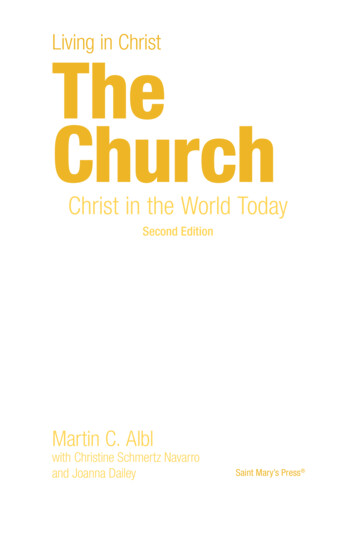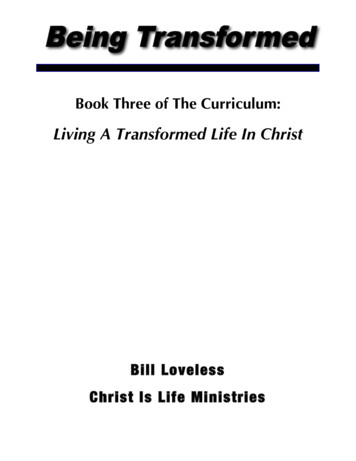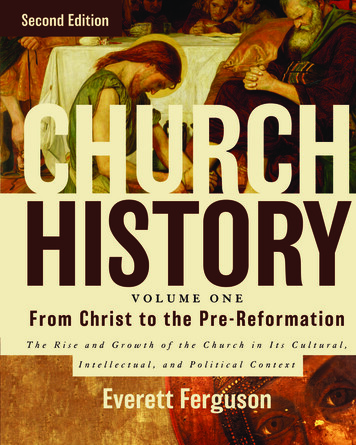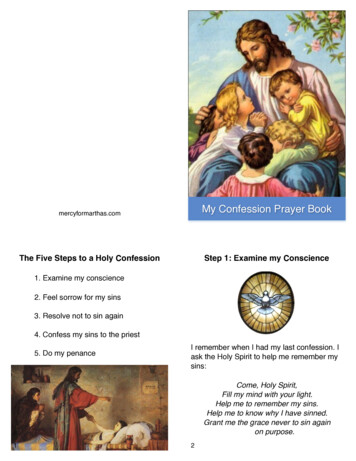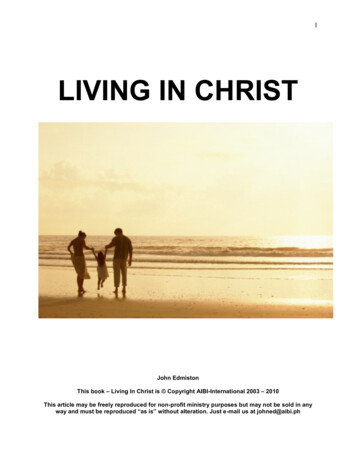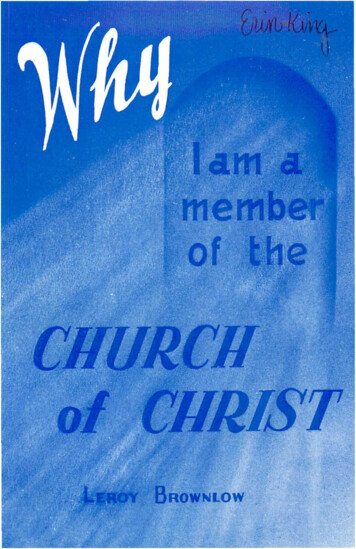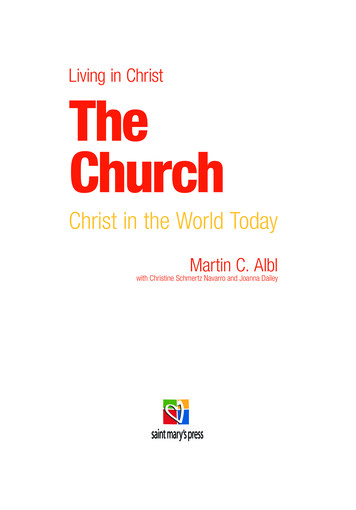
Transcription
Living in ChristTheChurchChrist in the World TodayMartin C. Alblwith Christine Schmertz Navarro and Joanna Dailey1149-TheChurch Pgs.indb 13/17/16 10:02 AM
The Subcommittee on the Catechism, United States Conference of CatholicBishops, has found that this catechetical high school text, copyright 2011, isin conformity with the Catechism of the Catholic Church and that it fulfillsthe requirements of Course IV: “Jesus Christ’s Mission Continues in theChurch” of the Doctrinal Elements of a Curriculum Framework for the Development of Catechetical Materials for Young People of High School Age.Nihil Obstat:Rev. William M. Becker, STDCensor LibrorumOctober 1, 2010Imprimatur:†Most Rev. John M. Quinn, DDBishop of WinonaOctober 1, 2010The nihil obstat and imprimatur are official declarations that a book or pamphlet is free of doctrinal or moral error. No implication is contained thereinthat those who have granted the nihil obstat or imprimatur agree with thecontents, opinions, or statements expressed, nor do they assume any legalresponsibility associated with publication.The publishing team included Maura Thompson Hagarty, PhD, theological reviewer; Christine Schmertz Navarro, development editor with StevenMcGlaun and Brian Singer-Towns; Joanna Dailey, section 4 sidebar andsection 5 author; prepress and manufacturing coordinated by the productiondepartments of Saint Mary’s Press.Cover Image: The Crosiers / Gene Plaisted, OSCCopyright 2011 by Saint Mary’s Press, Christian Brothers Publications,702 Terrace Heights, Winona, MN 55987-1320, www.smp.org. All rightsreserved. No part of this book may be reproduced by any means without thewritten permission of the publisher.Printed in the United States of America1149 (PO5489)ISBN 978-1-59982-060-6, Print1149-TheChurch Pgs.indb 23/17/16 10:02 AM
ContentsIntroduction. . . . . . . . . . . . . . . . . . . . . . . . . . . . . . . . . . . . . . . . . . . 7Section 1: The Church: Christ’s ContinuedPresence and Work in the WorldPart 1: The Origin of the Church . . . . . . . . . . . . . . . . . . 9Article 1: The Meaning of Church . . . . . . . . . . . . . . . . . . . . . . 10Article 2: God’s Call to Israel Foreshadows the Church. . . . . 13Article 3: Christ Instituted the Church. . . . . . . . . . . . . . . . . . . 15Part 2: The Holy Spirit and the Church . . . . . . . . . . . . 20Article 4: Introducing the Holy Spirit . . . . . . . . . . . . . . . . . . . . 21Article 5: Pentecost: The Church Revealed to the World. . . . 23Article 6: The Meaning of Pentecost. . . . . . . . . . . . . . . . . . . . 25Article 7: The Holy Spirit Animates, Sanctifies, and Builds theChurch. . . . . . . . . . . . . . . . . . . . . . . . . . . . . . . . . . . . 27Article 8: Life according to the Holy Spirit. . . . . . . . . . . . . . . . 30Article 9: The Holy Spirit Gifts the Church. . . . . . . . . . . . . . . . 32Part 3: The Work of the Early Church . . . . . . . . . . . . . 38Article 10: The Mission of the Apostles. . . . . . . . . . . . . . . . . . 39Article 11: Spreading the Gospel . . . . . . . . . . . . . . . . . . . . . . 42Article 12: Persecution and Martyrdom . . . . . . . . . . . . . . . . . 45Part 4: Images of the Church. . . . . . . . . . . . . . . . . . . . 49Article 13: The Church Is the People of God. . . . . . . . . . . . . . 50Article 14: The Church Is the Body of Christ. . . . . . . . . . . . . . 53Article 15: The Church Is the Temple of the Holy Spirit. . . . . . 571149-TheChurch Pgs.indb 33/17/16 10:02 AM
Section 2: The Church Is One, Holy,Catholic, and ApostolicPart 1: The Church Is One. . . . . . . . . . . . . . . . . . . . . . . 62Article 16: The First Mark of the Church. . . . . . . . . . . . . . . . . 63Article 17: Bonds of Unity . . . . . . . . . . . . . . . . . . . . . . . . . . . . 66Article 18: Wounds to Unity. . . . . . . . . . . . . . . . . . . . . . . . . . . 70Article 19: Ecumenism. . . . . . . . . . . . . . . . . . . . . . . . . . . . . . . 74Part 2: The Church Is Holy. . . . . . . . . . . . . . . . . . . . . . 79Article 20: Why Is the Church Holy? . . . . . . . . . . . . . . . . . . . . 80Article 21: The Church Makes Us Holy through God’s Grace.84Article 22: The Communion of Saints. . . . . . . . . . . . . . . . . . . 87Article 23: The Saints: Models and Intercessors. . . . . . . . . . . 89Article 24: Mary: Perfect Model of Holiness . . . . . . . . . . . . . . 92Part 3: The Church Is Catholic. . . . . . . . . . . . . . . . . . . 97Article 25: The Meaning of the Word Catholic. . . . . . . . . . . . . 98Article 26: Catholicity: The Fullness of Christ in theChurch. . . . . . . . . . . . . . . . . . . . . . . . . . . . . . . . . . 100Article 27: The Church’s Relationship with All People. . . . . . 102Article 28: Universality and Diversity. . . . . . . . . . . . . . . . . . . 106Part 4: The Church Is Apostolic. . . . . . . . . . . . . . . . . 111Article 29: The Apostles Continue Jesus’ Mission . . . . . . . . 112Article 30: Apostolic Tradition . . . . . . . . . . . . . . . . . . . . . . . . 114Article 31: The Successors to Peter and the Apostles. . . . . 117Article 32: The Apostolate of the Laity. . . . . . . . . . . . . . . . . . 120Section 3: The Church’s Salvation andMissionPart 1: The Church and Salvation . . . . . . . . . . . . . . . 125Article 33: The Fullness of Truth and Salvation. . . . . . . . . . . 126Article 34: Salvation for Those Outside the Church . . . . . . . 129Article 35: Who Needs Organized Religion?. . . . . . . . . . . . . 1321149-TheChurch Pgs.indb 43/17/16 10:02 AM
Part 2: The Church and the World. . . . . . . . . . . . . . . 137Article 36: Engaging the World . . . . . . . . . . . . . . . . . . . . . . . 138Article 37: Engaging Modern Culture. . . . . . . . . . . . . . . . . . 140Article 38: The Church and Evangelization. . . . . . . . . . . . . . 141Section 4: The Lived Mission of theChurchPart 1: The Leadership Structure of the Church. . . . 149Article 39: The Church and Hierarchy. . . . . . . . . . . . . . . . . . 150Article 40: The Pope: Visible Head of the Church. . . . . . . . . 153Article 41: The Role of the Bishops in the ChurchHierarchy. . . . . . . . . . . . . . . . . . . . . . . . . . . . . . . . 156Article 42: The Priesthood. . . . . . . . . . . . . . . . . . . . . . . . . . . 160Article 43: The Diaconate. . . . . . . . . . . . . . . . . . . . . . . . . . . . 163Part 2: Many Vocations to Holiness. . . . . . . . . . . . . . 168Article 44: The Evangelical Counsels. . . . . . . . . . . . . . . . . . . 169Article 45: The Mission of the Laity. . . . . . . . . . . . . . . . . . . . 172Article 46: The Work and Vocation of the Laity. . . . . . . . . . . 176Article 47: The Consecrated Life: Religious Orders . . . . . . . 179Article 48: Other Types of Consecrated Life. . . . . . . . . . . . . 182Part 3: The Magisterium: The Teaching Office of theChurch186Article 49: The Magisterium. . . . . . . . . . . . . . . . . . . . . . . . . . 187Article 50: Indefectibility and Infallibility. . . . . . . . . . . . . . . . . 190Article 51: The Magisterium and Truth. . . . . . . . . . . . . . . . . . 193Section 5: The Church and Young PeoplePart 1: You Have Been Called. . . . . . . . . . . . . . . . . . . 198Article 52: Called by God to Belong to the Church. . . . . . . . 199Article 53: Christ Enriches Us through Participation inthe Life of the Church. . . . . . . . . . . . . . . . . . . . . . 202Article 54: Called to Community . . . . . . . . . . . . . . . . . . . . . . 2061149-TheChurch Pgs.indb 53/17/16 10:02 AM
Part 2: Sent with the Holy Spirit. . . . . . . . . . . . . . . . . 211Article 55: Sent as a Disciple. . . . . . . . . . . . . . . . . . . . . . . . . 212Article 56: Discipleship in Daily Life. . . . . . . . . . . . . . . . . . . . 215Article 57: Empowered by the Holy Spirit. . . . . . . . . . . . . . . 219Glossary. . . . . . . . . . . . . . . . . . . . . . . . . . . . . . . . . . . . 224Index. . . . . . . . . . . . . . . . . . . . . . . . . . . . . . . . . . . . . . . 234Acknowledgments. . . . . . . . . . . . . . . . . . . . . . . . . . . . 2441149-TheChurch Pgs.indb 63/17/16 10:02 AM
IntroductionDear Reader,You are about to begin your study of the Church. In many ways studyingthis subject will be similar to studying any other subject: you will learnnew vocabulary, become familiar with some famous people in the Church,and be introduced to some new concepts and ways of thinking.But in other ways, this study will be unique, because the subject matter is unique. The Church is unlike any other reality on earth, because sheis both within history and beyond it. She is both human and divine. In theChurch we meet God.This study will engage not only your brain but also your heart andyour spirit—in other words, your whole self. You will be challengedmentally to understand teachings about the nature of the Church andgain a sense of how she has been present in the world throughout history. You also will be challenged in other ways—challenged to pray moredeeply with the Church and challenged to become a more committed andactive member of the Church. After all, you are a holistic person, madeup of body, mind, and spirit. This study will challenge you to broaden anddeepen all aspects of yourself.In writing this book, the editors and I have expanded our knowledgeabout the Church, have thought in new ways about the Church, and havegrown in our own commitment to and love for her. I invite you to share inthat experience.Sincerely,71149-TheChurch Pgs.indb 73/17/16 10:02 AM
Section 1TheChurchChrist’s ContinuedPresence and Workin the World1149-TheChurch Pgs.indb 83/17/16 10:02 AM
SectionPart 1#The Origin ofthe ChurchAs you begin your study of the Church, it makes senseto address questions about where the Church camefrom and who founded it . The Church was always part ofthe Father’s plan . It was instituted by his Son, Jesus Christ,and is given life by the Holy Spirit .The word Church refers to the assembly of peoplewhom God calls together to be in a special relationshipwith him . The Church was part of God’s saving plan fromall eternity . It is both the means of salvation and the goal ofhis plan . All people who are saved will be gathered into theperfected Church at the end of time .God formed a special relationship with Israel as hisChosen People, which foreshadowed his subsequentrelationship with the Church . God’s covenants with Israelprepared for the New Covenant established through Jesus’death and Resurrection .Jesus’ gift of the Eucharist and his saving death onthe cross gave birth to the Church . Jesus inaugurated theChurch by preaching about the Kingdom of God, healing people in mind and body, and calling people to bepart of his family . Jesus also established a structure forthe Church, based on the Twelve Apostles’ and Peter’sleadership . This structure will last until the fulfillment of theKingdom .The topics covered in this part are: Article 1: “The Meaning of Church” (page 10) Article 2: “God’s Call to Israel Foreshadows the Church”(page 13) Article 3: “Christ Instituted the Church” (page 15)91149-TheChurch Pgs.indb 93/17/16 10:02 AM
10Section 1: The Church: Christ’s Continued Presence and Work in the WorldeticlAr1The Meaningof ChurchLet’s begin by clarifying the meaning of the word church. Inthe everyday English language, the word church can refer todifferent realities, such as a building (“the big church downtown”), a parish (“I’m a member of Saint Mary’s Church”), aChristian eccesial community (“the Lutheran Church”), andthe Catholic Church. To understand how these are related, itis helpful to see how the earliest Christians understood andused this word.Defining ChurchThe hierarchy ofbishops and cardinals come from awide range of nationalities, ethnicities,and backgrounds,reflecting the diversity of the Church.The New Testament Greek word translated as church is ekklesia. It is related to the Greek verb ek-ka-lein, “to call out,” andthus refers to the convocation or assembly of people whomGod calls together to be in a special relationship with him.In the Greek Old Testament, ekklesia is used to refer to thepeople of Israel, an assembly chosen by God. The first Christians applied the term ekklesia to themselves to show thatthey were heirs of the assembly of Israel. In the Church, Godcalls people together from all over the earth.The word Church has three meanings in Christianusage, all of which involve God’s call: the entire community of God’s People around the world Franco Origlia/Sygma/Corbis01 Section 1.indd 105/12/16 12:12 PM
Part 1: The Origin of the Church11 the local community, which is a diocese or archdiocese, suchas the Archdiocese of Chicago the community assembled for liturgy, especially the Mass (forexample, the people gathered at Saint Charles Borromeo Par- dioceseAlso known as aish to celebrate the Eucharist at 10:00 a.m. on Sunday)It is impossible to separate these meanings from oneanother. The Church is all the people God gathers in theworld, but she exists concretely in local communities and ismade real in the assembly that gathers for liturgy, especiallyto celebrate the Eucharist. “She draws her life from the wordand the Body of Christ and so herself becomes Christ’s Body”(Catechism of the Catholic Church, [CCC], 752).The Father Planned the Church fromthe BeginningCalling together human beings is central to the Father’s planof salvation, as he wishes to gather us as his own people, thePeople of God, in order to save us. Jesus Christ, the only Sonof God, who is himself fully God, established the Churchwhen he proclaimed and ushered in the Kingdom of God.Even before the Church was instituted, the Father’seternal plan of calling together a holy people had alreadybeen taking shape in history. The Father’s call to the people“particular” or “local”Church, the regionalcommunity of believers, who commonlygather in parishes,under the leadershipof a bishop. At times, adiocese is determinednot on the basis ofgeography but on thebasis of language orrite.liturgyThe Church’s official,public, communalprayer. It is God’swork, in which thePeople of God participate. The Church’smost important liturgyis the Eucharist, or theMass.Live It!Living the Three Meanings of ChurchYou have many opportunities to live out each of the three meanings of the wordChurch in different ways:1. Develop a better sense of the universal nature of the Church by learningabout Catholic customs in other countries or praying for Catholics in othernations, especially those suffering persecution. You might also have anopportunity to attend World Youth Day.2. Get involved with your local diocese. Attend diocesan events for teens. Ifyour diocese has a youth board, consider serving as a member.3. Participate fully in the liturgy at your parish. You may have opportunities toserve in special roles, such as singing in the choir or lectoring.1149-TheChurch Pgs.indb 113/17/16 10:02 AM
12Section 1: The Church: Christ’s Continued Presence and Work in the World Saint Mary’s Press / Used with permission of St . Mary’s Catholic Churchof Israel to enter into acovenant relationship withhim was the clearest preparation for the Church. Goddesires that the wholehuman race, rather thansimply one people, maycome together as onePeople of God. Thus fromall eternity, God planned toform a Church as a meansof fulfilling that plan. How does celebrating the Eucharist in our local parish reflectthe three meanings of the word Church?God Created the Earth for the ChurchThe Shepherd of Hermas is an ancient Christian writing dating fromthe second century. The first part records a series of visions given toHermas, a Christian slave. In one, he sees an old woman carrying a bookthat reveals future events and the secrets of people’s hearts. Later, ina dream, a young man tells Hermas that the old woman is the Church.Hermas wonders why she is old, and is told: “Because she was createdfirst of all, for this reason she is old. And for her sake the world wasmade” (Visions 2.4).1149-TheChurch Pgs.indb 123/17/16 10:02 AM
Part 1: The Origin of the ChurcheticlAr213God’s Call to IsraelForeshadows the ChurchHave you ever wondered why more than half of the Bibleis composed of books that were written before the time ofChrist? The reason is that the Old Testament still has enormous value. Together with the New Testament, it hands onGod’s Revelation and makes known to us his plan of salvation. The Old Testament records the history of salvationfrom Creation through God’s Covenant with the Israelites,which foreshadows and prepares for the Church.foreshadowTo represent or prefigure a person beforehis or her life or anevent before it occurs.God’s Covenants with IsraelThe community of Israel foreshadows the Church. Just asGod chooses us to be saved as part of the Church, so too didGod call Israel as a nation to be his Chosen People as part ofhis larger plan of salvation.God called Abraham to leave his own country, promising him that he would father a great nation, Israel (see Genesis 12:2). Later God made a covenant with him, promisinghim land for himself and his descendants (see 12:15). Stilllater God entered into the Sinai Covenant. As the people’spart of the Covenant, God gave them his Law throughMoses at Mount Sinai. The Law is summarized in the Ten Scala / Art Resource, NYWhen the Israelites turned awayfrom God, Mosesinterceded with Godon their behalf. Howdoes this foreshadowJesus’ role as ourSavior?1149-TheChurch Pgs.indb 133/17/16 10:02 AM
14Section 1: The Church: Christ’s Continued Presence and Work in the WorldCommandments. Through the covenants, God established aspecial relationship with Israel as his Holy People.Universal Implications of God’s Call to IsraelGod’s special relationship with Israel was not just aboutIsrael: it had a deeper meaning for the rest of the world aswell. The prophets proclaimed a future when all nationswould gather together with Israel in true worship (see Isaiah2:2–5, Micah 4:1–4). The gathering of the people of Israelforeshadows the future gathering of all nations into onePeople of God.The Israelites, however, could not fulfill and were notalways faithful to their Covenant with God, straying awayto worship other gods, for example. The prophet Jeremiahspoke of God’s plan for a New Covenant between God andhis People (see Jeremiah 31:31–34).The perfect fulfillment of the Sinai Covenant, of theLaw, is the Son of God, Jesus Christ. As a Jew he was bornunder the Law, but by taking the people’s sins upon himself,he transformed the Law engraved on stone and engraved itupon his own heart. He is then the “covenant of the people”(Isaiah 42:6), God’s Servant who brings justice. In fulfillingthe Law of Sinai, however, Jesus did not abolish it. Insteadhe revealed its true meaning. Jesus thus initiated the NewCovenant at the Last Supper: “This cup is the new covenantin my blood, which will be shed for you” (Luke 22:20). Old Testament Images of the ChurchIn describing herself, the Church often draws on Old Testament images.Israel is pictured as God’s flock of sheep (see Psalm 77:20). Jesus refersto his followers as his “little flock” (Luke 12:32). Isaiah compares Israel toa vineyard (see chapter 5). Jesus calls his disciples the branches of thevine (see John 15:5).Christians often compare the Church to Israel’s Temple. They callthemselves “living stones” who form a “spiritual house” (1 Peter 2:5). Theircommunity is “the temple of God” (1 Corinthians 3:16, 2 Corinthians6:16) with Christ as the cornerstone (see 1 Peter 2:7, Matthew 21:42).Another image, dear to the Church Fathers, is the prefiguring of theChurch in Noah’s ark. The ark saves from flood waters, while the Churchsaves from sin.1149-TheChurch Pgs.indb 143/17/16 10:02 AM
15Part 1: The Origin of the ChurchAreticl3Christ Institutedthe ChurchWhen you think of people instituting an organization orcorporation, you may think of a ceremony or of men andwomen dressed in business suits and hard hats using shovelsto dig up the first dirt. Jesus did not institute the Churchin this way. This article explores how Jesus instituted theChurch.Jesus Preached the Kingdom of GodAt the time appointed by God, Jesus Christ, the eternal Wordof the Father, became man and lived among us on earth. Hetook on a human nature without losing his divine nature.The mystery of the union of the divine and human naturesin one Divine Person is called the Incarnation.During his earthly ministry, Jesus inaugurated theChurch through his preaching: “This is the time of fulfillment. The Kingdom of God is at hand” (Mark 1:15; see alsoCCC, 763). Jesus was drawing on the hope announced by theOld Testament prophets, who looked forward to a comingage when God’s will would be done on earth: “Then will theeyes of the blind be opened, / the ears of the deaf be cleared”(Isaiah 35:5).Catholic WisdomVatican II Teaching on the Church’s Relation to theJewish PeopleThe Vatican II document Declaration on the Relation of the Church to Non-ChristianReligions (Nostra Aetate, 1965), affirms that God loves the Jewish people anddecries all oppression of Jews. Many Jews have suffered unjust treatment becausethe sins of the Jews involved in Jesus’ death were wrongly extended to include allJewish people, even those in different times and places.Nevertheless, God holds the Jews most dear for the sake of their Fathers; He doesnot repent of the gifts He makes or of the calls He issues—such is the witness ofthe Apostle. . . . Although the Church is the new people of God, the Jews shouldnot be presented as rejected or accursed by God, as if this followed from the HolyScriptures.(Relation of the Church to Non-Christian Religions, 4)1149-TheChurch Pgs.indb 153/17/16 10:02 AM
16Section 1: The Church: Christ’s Continued Presence and Work in the WorldDuring his earthlyministry, Jesuspreached theKingdom of God.How does the Gospelmessage continue tobe taught today?Jesus’ message was intended for all people. Yet in aspecial way, Jesus directed his message to the poor andproclaimed that the nations would be judged on how wellthey took care of people who were hungry and thirsty (seeMatthew 25:31–46). Jesus also directed his message towardsinners, calling them to repentance and assuring them ofthe Father’s great mercy. Jesus’ message often took the formof parables, which challenged listeners to make the radicalchoice whether to truly follow him.Jesus’ listeners learned about the Kingdom not onlyfrom his words but also from his actions. Jesus’ miraclesand his healing of the sick were signs that the Kingdom hadalready begun on earth.Jesus Sent DisciplesTo help him establish the Kingdom of God, the Father gathered people to become Jesus’ first followers. Jesus sent outthese disciples to preach the Kingdom and to make disciples Brooklyn Museum/Corbis1149-TheChurch Pgs.indb 163/17/16 10:02 AM
Part 1: The Origin of the Church17of the nations, calling all people to join Christ’s Church. Thisgroup of followers, his disciples, became the Church, Jesus’true family, and the seed and beginning of the Kingdom onearth. The Church is thus a sign, as well as the actual beginning, of that perfect peace and happiness that all of us desire:the Reign of God mysteriously present in the world.Jesus Gave Himself Fully for the ChurchJesus established the Church primarily by the saving giftof himself. This gift, which was fulfilled on the cross, wasanticipated when Jesus instituted the Eucharist. Jesus’ words,“This is my body . . .” (Luke 22:19), expressed his completeself-giving in handing over his life for the sake of humanity. By participating in the Eucharist today, we share, in amystical way, in Christ’s sacrifice, and also in the grace thathis sacrifice gives the Church. This Sacrament also increasesthe unity of the People of God and enables us to share in thedivine life.Pray It!Praying the PsalmsJews and Christians continue to share the custom of praying the Psalms. Praywith the following excerpt, especially at times when you may struggle with yourself-worth:You formed my inmost being;you knit me in my mother’s womb.I praise you, so wonderfully you made me;wonderful are your works!My very self you knew;my bones were not hidden from you,When I was being made in secret,fashioned as in the depths of the earth.Your eyes foresaw my actions;in your book all are written down;my days were shaped, before one came to be.(Psalm 139:13–16)1149-TheChurch Pgs.indb 173/17/16 10:02 AM
18Section 1: The Church: Christ’s Continued Presence and Work in the WorldJesus Created the Structure of the ChurchhierarchyIn general, the lineof authority in theChurch; more narrowlythe Pope and thebishops, as successors of the Apostles,in their authoritativeroles as leaders of theChurch.Have you ever wondered why the Church is governed by apope and bishops? Jesus set up this structure himself. Heappointed the Twelve Apostles as the leaders of the community gathered around him (see Mark 3:14–19), and he gavePeter a special role as the head (see Matthew 16:18–19, Luke22:31).In order to build the Church and to proclaim the faith,Christ sent out his Apostles, giving them a share in his ownmission. He gave them, and those who have succeeded them,the power to act in his place. The bishops are the Apostles’successors, and the Pope, the Bishop of Rome, is the successor of Peter. The structure and hierarchy of the Churchestablished by Christ continues to this day and will remainuntil the Kingdom is fully established at the end of time.Whom Does Jesus Call?When Jesus gathered followers to help him proclaim and establish theKingdom, he did not call the most talented and powerful; rather, he choseordinary fishermen (see Mark 1:16–20) and even a tax collector (see2:13–17)—a person despised by most Israelites. Jesus’ choices areconsistent with Paul’s reminder that “God chose the weak of the world toshame the strong” (1 Corinthians 1:27). God’s call comes to everyone,even (or perhaps especially) to those who think they may not be worthy. Erich Lessing / Art Resource, NY1149-TheChurch Pgs.indb 183/17/16 10:02 AM
Part 1: The Origin of the Church19Jesus’ choice of Twelve Apostles reflects the TwelveTribes of Israel, God’s Chosen People. This aspect of Jesus’inauguration of the Church recalls the Jewish hope thatsomeday the Twelve Tribes, scattered in exile, would be gathered together again. Part Review1. What are three meanings of the word Churchin Christian usage?2. What is the Church’s role in the Father’s planto save us?3. Why was God’s Covenant with Israel significant for the rest of the world?4. How is Jesus the perfect fulfillment of the SinaiCovenant?5. How did Jesus establish the Church throughhis preaching?6. How is Jesus’ self-giving on the cross relatedto his establishment of the Church?1149-TheChurch Pgs.indb 193/17/16 10:02 AM
20Section 1: The Church: Christ’s Continued Presence and Work in the WorldPart 2The Holy Spiritand the ChurchIn this section we study the Holy Spirit’s action in the Church . Thefirst article introduces the Holy Spirit, the Third Divine Person of theHoly Trinity . We see that although the Holy Spirit is revealed throughout the Scriptures, he was not fully revealed until Pentecost, afterJesus had died, risen from the dead, and ascended into Heaven . TheHoly Spirit and Christ are inseparable in their mission .We then look at the actual account of Pentecost in the Acts ofthe Apostles and see how Christ poured out the Holy Spirit upon theChurch that day . Subsequently, we look at the significance of Pentecost as the Revelation of the Church, the Holy Spirit, and the Trinity .We consider the ways the Holy Spirit animates, sanctifies,and builds the Church . We learn what Saint Paul means when hedescribes a new kind of life according to the Holy Spirit . A life according to the Holy Spirit is full of love and joy instead of selfishness,conflict, and a blind focus on short-term pleasure . The Holy Spirit’srole in this new life includes teaching us to pray .We conclude this part by learning about special gifts from theHoly Spirit, known as charisms . These include extraordinary gifts,such as speaking in tongues and miraculous healing, but also moreordinary gifts, such as leadership and teaching .The topics covered in this part are: Article 4: “Introducing the Holy Spirit” (page 21) Article 5: “Pentecost: The Church Revealed to the World” (page 23) Article 6: “The Meaning of Pentecost” (page 25) Article 7: “The Holy Spirit Animates, Sanctifies, and Builds theChurch” (page 27) Article 8: “Life according to the Holy Spirit” (page 30) Article 9: “The Holy Spirit Gifts the Church” (page 32)201149-TheChurch Pgs.indb 203/17/16 10:02 AM
Part 2: The Holy S
and the Body of Christ and so herself becomes Christ's Body" (Catechism of the Catholic Church, [CCC], 752). The Father Planned the Church from the Beginning Calling together human beings is central to the Father's plan of salvation, as he wishes to gather us as his own people, the People of God, in order to save us. Jesus Christ, the .

